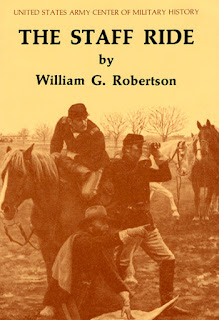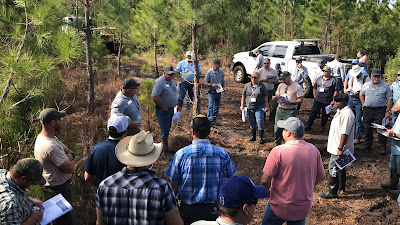You and your team are heading home from an incident and come up on the location of a fatality event. You pull over and proceed to walk around the site and have a few deep discussions here and there about the events of the incident. Someone even pulls up the accident report. Is it a staff ride (your entire team is there) or a site visit?
The intent of a staff ride is to put participants in the shoes of the decision makers on a historical incident in order to learn for the future. A staff ride should not be a tactical-fault finding exercise. Participants should be challenged to push past the basic question of "what happened" and examine the deeper questions of leadership and decision making:
Staff Ride
A field study that is conducted on the ground where an incident or event happened. A staff ride consists of three distinct phases:
A staff ride should avoid being a recital of a single investigation report. Such reports rarely address the human factors that affect individual decision-making. For this reason, providing participants with a variety of information sources is important.
Case Study
A visit to the actual location associated with an incident or event to provide opportunity to gain meaningful perspective and insight.
To answer our original question, you and your team have conducted a site visit. Chances are you have not fully engaged in the preliminary and integration phases.
This does not make your exercise insignificant, it just doesn't meet the parameters for a staff ride as prescribed in the Wildland Fire Staff Ride Guide.
 | |
|
- "What would I have done in this person's place?"
- "How detailed should the guidance from a superior to a subordinate be?"
- "Can a senior leader make use of a competent but overzealous subordinate?"
- "What explains repeated organizational success or failure?"
Staff Ride
A field study that is conducted on the ground where an incident or event happened. A staff ride consists of three distinct phases:
- a systematic Preliminary Study of a selected fire or other emergency operation,
- an extensive Field Study to the actual site(s) associated with the incident, and
- an opportunity for Integration of the lessons derived from the study and visit.
A staff ride should avoid being a recital of a single investigation report. Such reports rarely address the human factors that affect individual decision-making. For this reason, providing participants with a variety of information sources is important.
Case Study
- An analysis of persons, events, and decisions that are studied holistically.
- Does not need to be conducted at the site of the incident, but could include a visit to the incident location.
- Case studies are used to demonstrate a thesis or principle.
- Case studies are led and require facilitation.
A visit to the actual location associated with an incident or event to provide opportunity to gain meaningful perspective and insight.
 |
| (Photo credit: Idaho City IHC; Rattlesnake Fire) |
Virtual Site Visit
A virtual site visit follows the same methodology as a "live" or "field" staff ride, but because travel restrictions preclude a trip to the incident location, the terrain is replicated in a virtual environment.
Material from virtual site visits may be used to help conduct case studies and staff rides.
A virtual site visit follows the same methodology as a "live" or "field" staff ride, but because travel restrictions preclude a trip to the incident location, the terrain is replicated in a virtual environment.
Material from virtual site visits may be used to help conduct case studies and staff rides.
Wildland Fire Leadership Challenge
- Visit the Staff Ride Library on the Wildland Fire Leadership Development Program website.
- Download and read the Wildland Fire Staff Ride Guide.
- Develop a staff ride for a local incident using the Staff Ride Development Template.
- Preview some of the national staff rides in the Staff Ride Library.
To answer our original question, you and your team have conducted a site visit. Chances are you have not fully engaged in the preliminary and integration phases.
This does not make your exercise insignificant, it just doesn't meet the parameters for a staff ride as prescribed in the Wildland Fire Staff Ride Guide.
For more information or questions regarding staff rides, contact George Risko (Florida Forest Service), Staff Ride Coordinator.



No comments:
Post a Comment